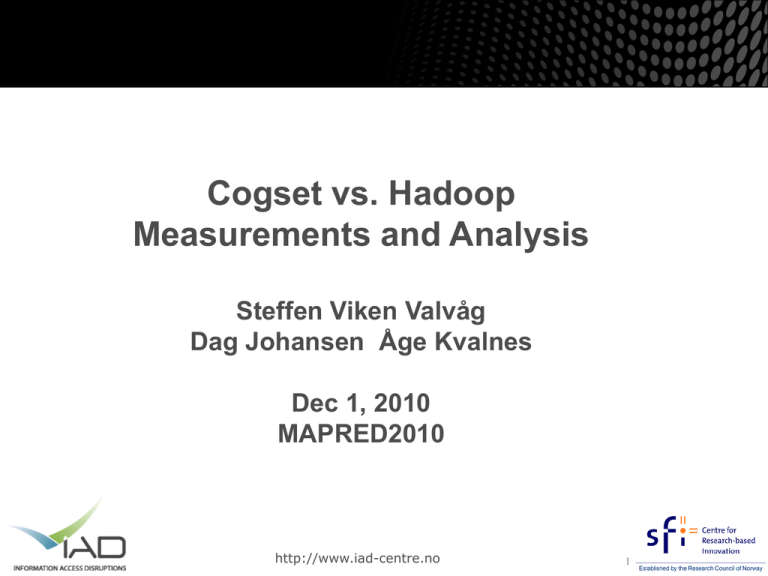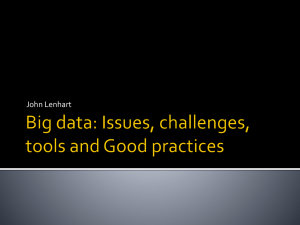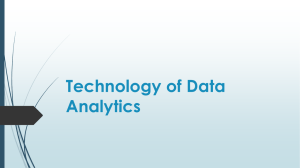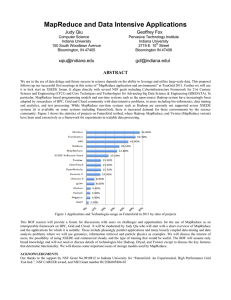Cogset vs. Hadoop Measurements and Analysis Steffen Viken Valvåg
advertisement

Cogset vs. Hadoop Measurements and Analysis Steffen Viken Valvåg Dag Johansen Åge Kvalnes Dec 1, 2010 MAPRED2010 http://www.iad-centre.no 1 Context and Background – Part of the international research project iAD, focusing on information access applications – Hosted by the Norwegian search company FAST (now a Microsoft subsidiary) in collaboration with: • Cornell University (Cornell), Dublin City University (DCU), BI Norwegian School of Management (BI), Norwegian University of Science and Technology (NTNU), University of Oslo (UiO), University of Tromsø (UiT), Accenture – Broad range of research topics, including run-times to facilitate distributed data processing (analytics) in cloud environments. http://www.iad-centre.no 2 Analytics (large scale data processing) – Analytics are important for information access applications • Constructing indexes, analysing trends, sentiments, and link structures, mining and correlating logs, recommending items, etc. • Data-intensive computations that must be distributed for efficiency – Run-times automate scheduling of processes on cluster machines, monitor progress, ensure fault tolerance, and support efficient data transfer between processes. – Widely adopted framework (and programming model): MapReduce • Hadoop is the most widely deployed open source implementation http://www.iad-centre.no 3 Cogset – A generic engine for: • Reliable storage of data • Parallel processing of data – Inspired by both MapReduce and databases • • • • Schema-free data model Data processing with user-defined functions Push-based static routing of records Novel mechanisms for fault tolerance and load balancing – Supports several high-level programming interfaces • Oivos (NPC2009): Declarative workflows • Update Maps (NAS2009): Key/value interface • MapReduce: Compatible with Hadoop http://www.iad-centre.no 4 Overview of Cogset – Data sets are stored as a number of partitions • Distributed and replicated for redundancy – Data is accessed by performing traversals • Functional interface, specifying a user-defined visitor function (UDF) to be invoked in parallel for all partitions. • Visitors may read multiple data sets and add records to multiple new or existing data sets. • Output is atomically committed once a traversal completes. http://www.iad-centre.no 5 Partitioning Data sets Partitions Nodes 1 1 5 5 2 3 1 1 2 4 5 1 3 2 2 3 http://www.iad-centre.no 1 2 3 4 5 3 2 3 4 4 5 4 4 5 Traversals – High-level algorithm: • For each partition, select a node that is hosting the partition and evaluate the visitor function there • Collect output records from the visitor and route them to the appropriate nodes • Once all partitions are processed, commit all output – Implementation: • Fully distributed scheduling algorithm • Each node monitors and coordinates with its “neighbors”, which are nodes with replicas in common • Slow nodes are detected and off-loaded by their neighbors • Status and progress is reported to the client, which acts as the “master” for a given traversal http://www.iad-centre.no 7 Data placement and locality – Motivation for integrating storage and processing • When storage is decoupled from processing, data locality is harder to ensure – Clients may influence data locality by choosing how to partition data • Corresponding partitions of different data sets are always colocated, and accessible together by a visitor function – Example: Hash join • With Cogset, a hash join can be implemented by a single traversal without repartitioning data • With traditional MapReduce, a hash join must first repartition all data in the Map phase http://www.iad-centre.no 8 MapReduce support in Cogset – Highly compatible with Hadoop • Construct a JobConf object in the regular way, then run the job using Cogset rathen than Hadoop. • New-style interfaces (Hadoop 0.19+) also supported – Implemented as two traversals • The first traversal implements the map phase, using a visitor that reads all input records and passes them to the user-defined Mapper (and Combiner). • The second traversal implements the reduce phase, sorting each partition and applying the Reducer. http://www.iad-centre.no 9 The MR/DB benchmark – Developed by Pavlo et al. for the SIGMOD 2009 paper “A comparison of approaches to large-scale data analysis” – Designed to compare the performance of MapReduce and Parallel Databases. • Originally used to compare Hadoop, Vertica, and a second parallel database system (DB-X). • Subsequently used to evaluate HadoopDB in a separate paper. • Features 5 tasks that may be expressed either as SQL queries or as MapReduce jobs, with provided source code for Hadoop. – We used MR/DB to compare the performance of Cogset, when employed as a MapReduce engine, to Hadoop. • The exact same MapReduce benchmark code was executed using both Hadoop and Cogset http://www.iad-centre.no 10 MR/DB benchmark tasks – Grep: Sequential scan of a data set • 1 map-only job CREATE TABLE Data (key VARCHAR(10) PRIMARY KEY, field VARCHAR(90)); SELECT * FROM Data WHERE field LIKE ‘%XYZ%’; – Select: Sequential scan, less selective • 1 map-only job CREATE TABLE Rankings (pageURL VARCHAR(100) PRIMARY KEY, pageRank INT, avgDuration INT); SELECT pageURL, pageRank FROM Rankings WHERE pageRank > X; http://www.iad-centre.no 11 MR/DB benchmark tasks – Aggregate: Aggregate total revenue per IP • 1 full MapReduce job CREATE TABLE UserVisits (sourceIP VARCHAR(16), destURL VARCHAR(100), visitDate DATE, adRevenue FLOAT, userAgent VARCHAR(64), countryCode VARCHAR(3), languageCode VARCHAR(6), searchWord VARCHAR(32), duration INT ); SELECT sourceIP, SUM(adRevenue)FROM UserVisits GROUP BY sourceIP; http://www.iad-centre.no 12 MR/DB benchmark tasks – Join: Complex two-way join + aggregation • 3 MapReduce jobs SELECT INTO Temp sourceIP, AVG(pageRank) as avgPageRank, SUM(adRevenue) as totalRevenue FROM Rankings AS R, UserVisits AS UV WHERE R.pageURL = UV.destURL AND UV.visitDate BETWEEN Date(‘2000-01-15’) AND Date(‘2000-01-22’) GROUP BY UV.sourceIP; SELECT sourceIP, totalRevenue, avgPageRank FROM Temp ORDER BY totalRevenue DESC LIMIT 1; http://www.iad-centre.no 13 MR/DB benchmark tasks – UDF: Parse hyperlinks from a set of HTML documents and invert the link graph • 1 MapReduce job CREATE TABLE Documents (url VARCHAR(100) PRIMARY KEY, contents TEXT ); SELECT INTO Temp F(contents) FROM Documents; SELECT url, SUM(value) FROM Temp GROUP BY url; • F is a user-defined function that must be integrated into the query plan by the parallel databases http://www.iad-centre.no 14 MR/DB results for 25 nodes – Cogset improves performance significantly for several benchmark tasks – When investigating, we also discovered ways to improve Hadoop’s benchmark performance by making various optimizations (these results are labeled “Optimized Hadoop”) http://www.iad-centre.no 15 Hadoop bottleneck: Task scheduling – Hadoop’s task trackers communicate with the central job tracker using heartbeat RPCs • Heartbeats occur at most every 3 seconds, and task completion is only reported then • Consequently, task trackers may go idle if tasks are short-lived – Unexpected interaction with HDFS block size • Bigger block size = more work per mapper = less idle time – For Grep, task trackers were idle 34% of the time using the default Hadoop configuration • A simple patch allowed us to report completed tasks immediately – Hadoop 0.21 introduced a new option that may help • mapreduce.tasktracker.outofband.heartbeat • Enable this to send out-of-band heartbeats upon task completion http://www.iad-centre.no 16 Hadoop bottleneck: Multi-core CPU utilization – For sequential scanning of data, and whenever costly UDFs are invoked, Hadoop quickly becomes CPU bound • Multiple cores are not well utilized, so there may well be spare CPU cycles that go unused • Increasing the number of concurrent processes is ineffective, because of memory footprint and less optimal I/O access patterns – Cogset employs multiple threads to read, parse and process records in parallel • Fully exploits all cores when costly UDFs are employed – By implementing a similar approach in Hadoop, plugged in as a custom input format, performance was greatly improved http://www.iad-centre.no 17 Relative performance to other systems – When comparing the relative performance to Hadoop, Cogset matches the performance of previously benchmarked parallel database systems • Index structures skew some results in favor of the parallel database systems • For sequential scanning and aggregation, Cogset matches or outperforms Vertica and DB-X. http://www.iad-centre.no 18 Conclusion – The MR/DB benchmark primarily exposed implementation weaknesses in Hadoop; the results are not due to fundamental limitations of the MapReduce programming model • Cogset matches the performance of parallel databases while supporting the MapReduce programming model – Previous criticism of the MR/DB benchmark has pointed out that the UDFs and record formats employed are inefficient • Cogset tolerates costly UDFs using multi-threading • This closes much of the performance gap to parallel databases • Similar improvements are possible with Hadoop, but may require some restructuring – Hadoop’s task scheduling is prone to leaving nodes idle • Serious problem that affects both throughput and latency • Straightforward to fix http://www.iad-centre.no 19 Questions? http://www.iad-centre.no 20 http://www.iad-centre.no 21 http://www.iad-centre.no 22 How Cogset improves performance – Direct routing of data between computing nodes • • Avoids temporary storage of transient data Entails novel approaches to fault tolerance and load balancing – Visitor-based data processing integrated into the storage layer • Transfer the code to the data to reduce bandwidth consumption – Fully distributed scheduling and monitoring algorithm • Monitors peers with common data replicas and dynamically balances load – Multi-threaded program structure to exploit all available CPU capacity • Essential for good performance on multi-core architectures – Experience with Cogset also used to improve Hadoop in several ways • • • Inefficient scheduling algorithm identified and improved Performance critical Cogset code refactored into Hadoop plugins CPU hotspots reduced using multi-threaded code on the critical path http://www.iad-centre.no 23




